Michel Etienne, Christophe Le Page and Mathilde Cohen (2003)
A Step-by-step Approach to Building Land Management Scenarios Based on Multiple Viewpoints on Multi-agent System Simulations
Journal of Artificial Societies and Social Simulation
vol. 6, no. 2
To cite articles published in the Journal of Artificial Societies and Social Simulation, please reference the above information and include paragraph numbers if necessary
<https://www.jasss.org/6/2/2.html>
Received: 8-Mar-2003 Accepted: 14-Mar-2003 Published: 31-Mar-2003
 Abstract
Abstract

|
| Figure 1. The UML class diagram of the model |

|
| Figure 2. The farmers' activity diagram |

|
| Figure 3. The foresters' activity diagram |

|
| Figure 4. The conservationists' diagram |

|
| Figure 5. The spatial grid of the model from the "vegetation forms" viewpoint |
| Scenario | Parties* | Main objective | Key markers used by stakeholders |
| 1 | F | Back to woodlands | Forest stands, sylviculture |
| 2 | S | Preserve current production | Stocking rate |
| 3 | C | Preserve current habitats | Flora, fauna and landscape heritage |
| 4 | C | Immediate return to grasslands | Grassland area |
| 5 | F + C | Control pine seed source | Ridges, natural heritage |
| 6 | C + S | Long-term environmental agriculture | Work effort, natural heritage |
| 7 | S + F + C | Sustainable timber and grass production | Timber production, stocking rate, natural heritage, working effort |
| 8 | S + F + C | Progressive return to grasslands | Timber production, stocking rate, natural heritage, working effort |

|
| Table 2. Sequences of basic processes for the 8 simulation scenarios. Each line represents a basic operation, each column represents a scenario (as described in table 1). When the intersection between a line and a column appears in grey, it means that the corresponding basic operation is activated for the corresponding scenario. |
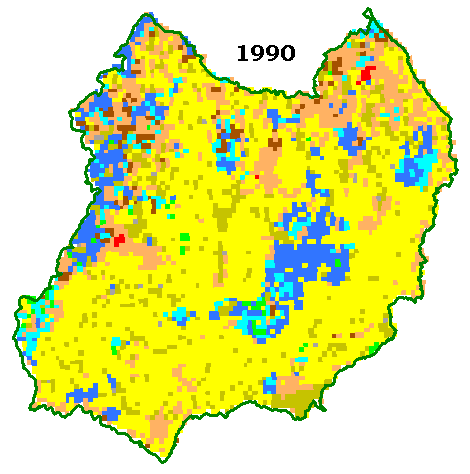
|
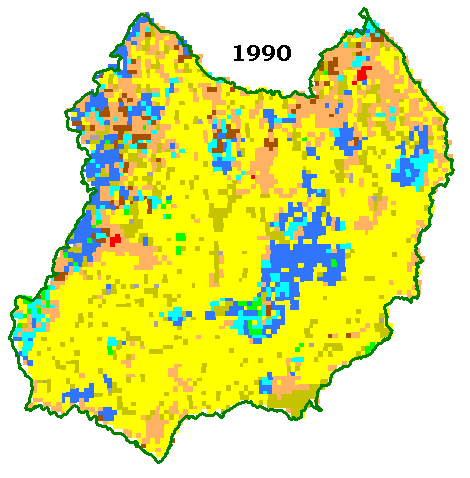
|
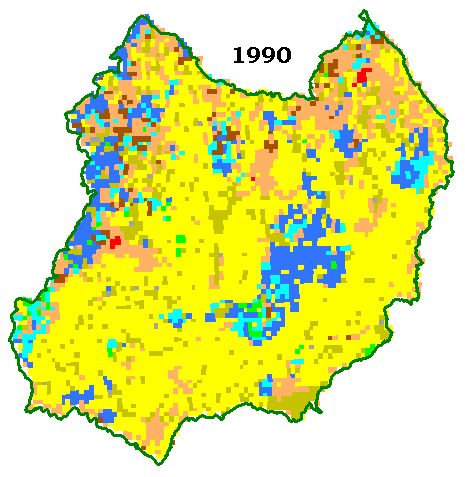
|
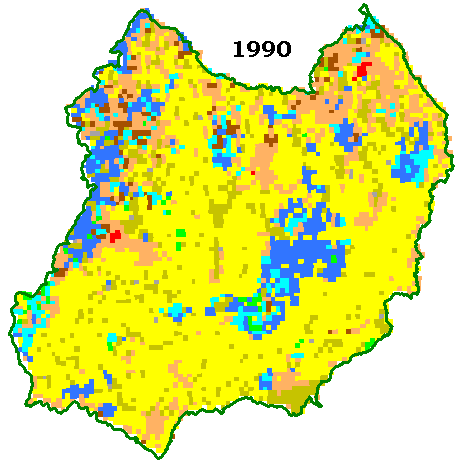
|
in which Scots pine would stand and Austrian black pine afforestation would be eliminated and spontaneously replaced by native grasslands newly devoted to grazing. They assumed that the current ecological process of pine encroachment was too strong and widely distributed to be controlled without a drastic decision such as the complete eradication of adult pine stands.
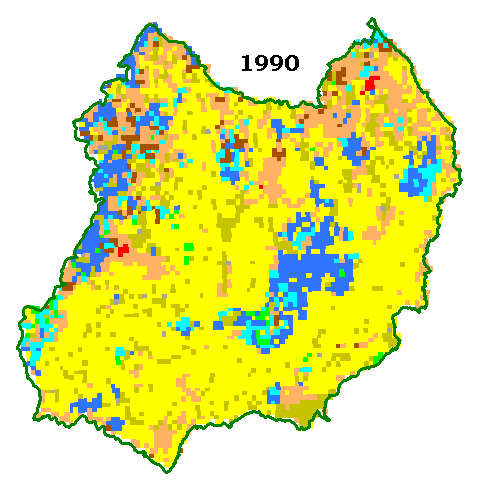
|
But much time had passed since the beginning of the encroachment process until the moment trees were visible to farmers, park rangers or foresters. Besides, it was important for the modeller to be able to show clearly to the stakeholders the progress of the pine overspread. The best criterion to express the ongoing process was to visualise the location of the trees according to age. A colour represented each important succession stage (seed establishment, seedling development, savannah-like stand, and forest stand). Shades accounted for gradients during the same stage. Each time a cell was invaded by new pine seeds it became pink, then, while pine trees were growing without being easily visible, the colour of the cell turned from green to yellow. When pine trees became part of the landscape (ages ranging from 10 to 30 years), the cell colour turned into an increasingly darker shade of red. Over 30 years of age, pine trees were supposed to belong to manageable forest stands and the cell turned into shades of blue (figure 6).
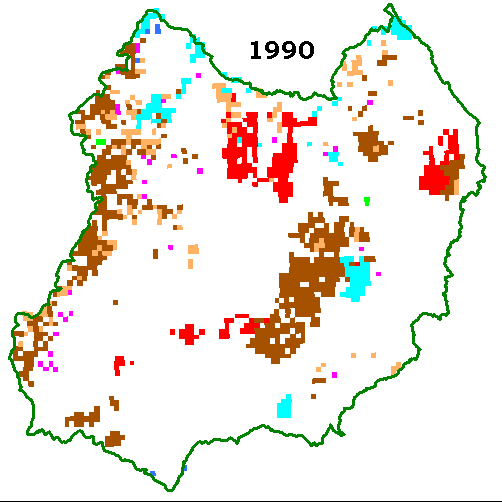
|

|
| Figure 6. The spatial grid of the model from the modeller's viewpoint, based on the ages of the trees |

|
| Figure 7. The spatial grid of the model from the forester's viewpoint, based on the species and the density of the trees |

|
| Figure 8. The landscape units of the spatial grid of the model, as defined by the conservationists |

|
| Figure 9. The spatial grid of the model from the conservationist's viewpoint, based on a heritage index |

|
| Figure 10. The spatial grid of the model from a viewpoint designed to visualise the ridges located on the eastern edge of pine afforestations |

|
Scenario 6 originated from the wish of National Park rangers to support farmers with environmental awareness and ecological practices to follow up on the agro-environmental measures taken by the European Union. Once farmers had been rated according to the quality of their practices in terms of ecological impact, the conservationists shared with the best-ranked farmers the work or cost of eradication of the pines. Both sets of people asked for a viewpoint on the work effort for pine cutting or mowing, to have an idea of the intensity and frequency of work they would have to put in the field. Farmers or rangers could control pine encroachment by either chain mowing (blue shades) or hand clearing (red shades). The darker the shade, the higher the frequency of intervention for getting rid of the pine trees. The first cuts were painted green in order to figure out easily, at the end of the simulation, the stands initially dominated by pine trees and exploited for timber (figure 11).

|
| Figure 11. The spatial grid of the model from a viewpoint related to the intensity and frequency of work effort for pine cutting or mowing |

|
Scenario 7 intensified the management of pine woodlands through a strong thinning of stands over 40 years old on 20-ha plots in order to set up rapidly rational grazing and to produce enough timber to make the venture worthwhile for loggers. It required the approval of the owner when the land did not belong to the farmers and it made it possible to anticipate the final harvest when the trees were about 60 years old.
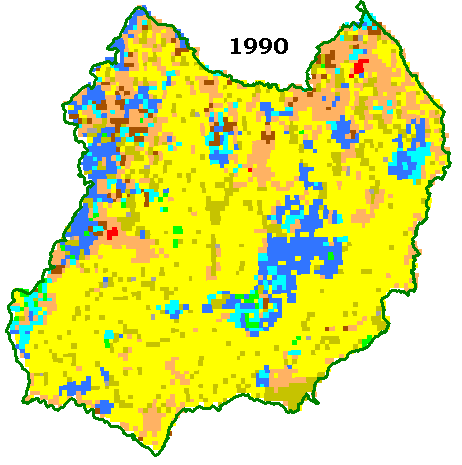
|
Scenario 8 was restricted to pine woodlands located in owned or rented farms. It consisted in operating 2 or 3 rounds of thinning on encroached cells as early as the pines were over 20 years old. Thinning was scheduled every ten years until trees were 50 years old in order to maintain a relatively thin tree canopy that warranted the presence of a dense layer of grass, thus avoiding the woodland tax[1]. As farmers pointed out that this type of operation was time-consuming and provided no financial income during the first thinning period they decided to practise thinning only when they began to suffer from a lack of forage on native pastures.

|
| Figure 12. The spatial grid of the model from a viewpoint related to the sylviculture, with emphasis on the sylvopastoral management |

|
| Figure 13. Evolution of the surface covered by dense woodlands for the 8 scenarios |

|
| Figure 14 |
BOUSQUET F, BAKAM I, PROTON H and LE PAGE C (1998): "Cormas: Common-Pool Resources and Multi-Agent Systems". Lecture Notes in Artificial Intelligence, 1416, pp. 826-837.
BOUSQUET F, BARETEAU O, D'AQUINO P, ETIENNE M, BOISSAU S, AUBERT S, LE PAGE C, BABIN D and CASTELA JC (2002): "Multi-agent systems and role games: an approach for ecosystem co-management". In Janssen M (ed.), Complexity and ecosystem management: the theory and practice of multi-agent approaches,Elgar Publishers, Northampton, England, pp. 248-285.
COSTANZA R and RUTH M (1998): "Using dynamic modeling to scope environmental problems and build consensus". Environmental Management, 22, pp. 183-195.
ETIENNE M (2001): "Pine trees - invaders or forerunners in Mediterranean-type ecosystems: a controversial point of view". Journal of Mediterranean Ecology, 2(3-4), pp. 221-232.
ETIENNE, M., and LE PAGE C (2002): "Modelling contrasted management behaviours of stakeholders facing a pine encroachment process: an agent-based simulation approach". Proceedings International Environmental Modelling and Software Society Conference, Lugano, Switzerland, June 2002, pp. 208-213.
GIMBLETT H, ROBERTS C, DANIEL T, RATLIFF M, MEITNER M, CHERRY S, STALLMAN D, BOGLE R, ALLRED R, KILBOURNE D and BIERI J (2002): "An intelligent agent-based model for simulating and evaluating river trip scenarios along the Colorado River in Grand Canyon National Park". In: Gimblett H (ed.), Integrating geographic information systems and agent-based modelling techniques for simulating social and ecological processes. Oxford University Press, pp. 245-275.
HOLLING C (1978): Adaptive environmental assessment and management, John Wiley, London.
JESTIN P and ROUSELLE P (1997): Catalogue de la flore du Parc National des Cévennes.Parc National des Cévennes, Florac, France.
LEPART J, MARTY P and ROUSSET O (2000): " Les conceptions normatives du paysage. Le cas des Grands Causses ". Natures, Sciences et Sociétés, 8(4), pp. 16-25.
O'ROURKE E (1999): "The Causse Méjan: changing relationships between agriculture, environment and society within a French National Park". Landscape Research, 24(2), pp. 141-165.
OSTY P-L, LARDON S, LHUILLIER C (1994): " Systèmes techniques et gestion de l'espace : quelle qualité de l'organisation spatiale ? Les élevages ovins du Causse Méjan ". Études et Recherches sur les Systèmes Agraires et le Développement, 28, pp.211-218.
PARC NATIONAL DES CÉVENNES(1999): Atlas du Parc National des Cévennes. ATEN, Montpellier, France.
Return to Contents of this issue
© Copyright Journal of Artificial Societies and Social Simulation, [2003]